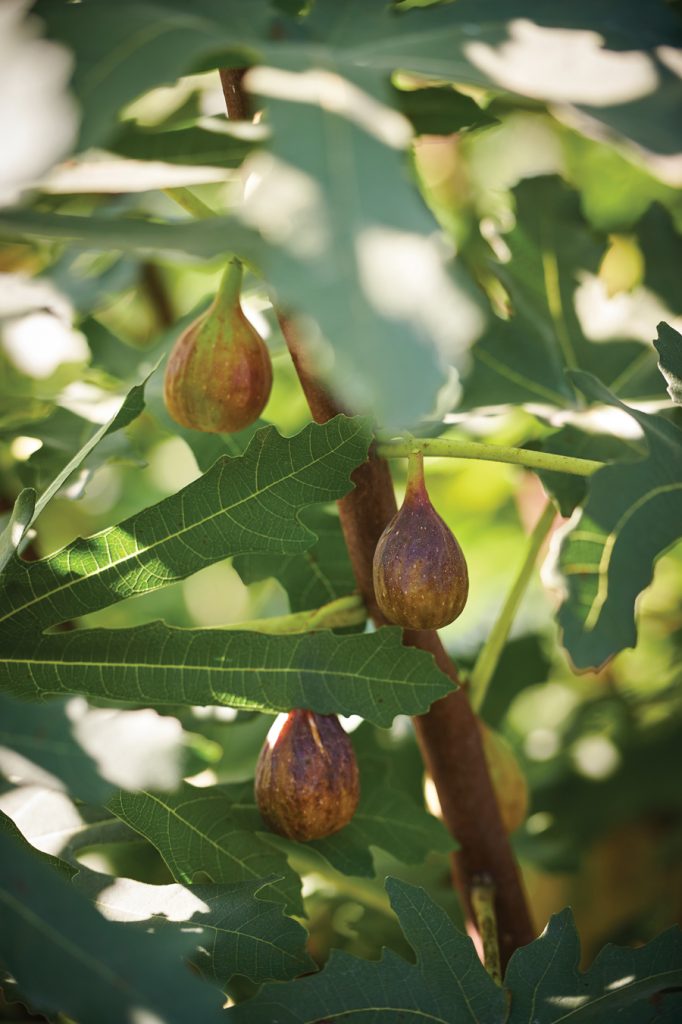The Mad Scientist of Figs
Originally published in the May 2021 issue of LCM

In the world of horticulture, some gardeners collect roses, while others focus on daffodils, tulips, water lilies and hosta. Others are obsessed with orchids. Tomato connoisseurs are always searching for elusive heirlooms. Then, there’s Bill Lauris, whose fondness for figs has grown into a full-fledged nursery.
Late last summer, our next-door neighbor, Marie Shirk, left a quart of fresh figs at our door. Having never seen a fresh fig, I wasn’t sure how to eat them. Biting into the delicate skin, my question was answered. Sweet like candy (imagine a raspberry jam-like texture and flavor) or delivering a nutty flavor (sometimes with chocolate or honey undertones), figs are perfect on their own. In fact, in some cultures, the fig epitomizes a healthy snack or addition to a meal – sort of the way Americans relate to apples.
Oddly enough, Marie’s gift accounted for the second time that day I heard of figs being grown in Lancaster County. I took it as a sign, with all paths leading to a chemistry teacher named Bill Lauris.
Off the Beaten Path
It was early autumn when I met Bill at his home near Rohrerstown. A full-time chemistry teacher at Veritas Academy in Leola, Bill operates Off the Beaten Path Nursery in his spare time. The unassuming turn-off from the Rohrerstown Road provides a hidden portal into a secret garden of uncommon treasures. That’s where we started our time together, with Bill introducing me to a few pet projects that were growing on his property.
First up in a cornucopia of delights were Salavatski Russian pomegranate trees, which he planted just to see if he could get them to grow. Around the deck you encounter a small cranberry bog, ingeniously supplied with water from an HVAC condenser unit. Nearby is a jujube tree, a Chinese fruit much like a miniature apple that eventually transforms into a “red date.” A few steps later, we come to a Szechuan pepper plant and the realization I never considered how peppercorns grow. Its tangy citrus aroma and flavor come with an enduring heat that while pleasant, delivers the subtle tingling of having licked a 9V battery.

Further into Bill’s property sits a quaint greenhouse that’s surrounded by hundreds of lush green trees. “As a kid, we had a peach tree and it produced so many peaches that I was thinking, when I get my first house, I’m going to put a bunch of fruit trees in and grow my own fruit,” Bill recalls.
Bill’s interest in fig trees started more than 20 years ago while shopping at a local nursery with his mother. “We were in the herb section and I noticed this interesting coconut smell,” he says of what he learned was a Black Mission fig. “I’ll never forget it,” he says of the memory. “It had some fruit on it, but it wasn’t ripe.” Intrigued, he bought it.
That fig tree was unlikely to make it for several reasons and come winter, it indeed died. Not ready to give up, Bill later found a second fig tree at another nursery, again in the herb section. This variety grew successfully and eventually produced fruit. “That tree still lives where I planted it on Delp Road. It’s still there, right against the foundation of the house. I took cuttings and sell it as Unknown Italian Purple,” says Bill. However, Bill originally referred to it as Brown Turkey, which, he explains, “is sort of a generic term for when you don’t know what variety it is.”
Meeting the Guru of Figs
Looking for the answer to the mystery fig’s identity led Bill to meet Bass Samaan, the owner of Trees of Joy, a nursery in Bethlehem, Lehigh County. Bill still recalls meeting Bass for the first time – with his first fig – and saying, “I got the dark one, I just need the light one.”
The comment was met with a smile on the part of Bass. “I didn’t get why he was smiling; [I guess] he thought it was funny.” Bill then posed the question, “There’s just two, right?” That’s when he learned the reason for Bass’s smile. “Here I am, 300 varieties later, still looking for whatever elusive thing is still out there,” Bill continues. “Every year I promise myself, I don’t have any more room; is [another variety] going to be different from an x, y or z fig? But there’s something about it that always will bring me in. If it’s history or if it’s flavor or color, there’s always a shiny new object out there. Every single season, I say I’m not falling for it, nope! We all know how that goes!”

As for Bass Samaan, Bill points out, “In 2008, Bass was really ahead of the curve. He was the first one that I knew of who made money selling fig trees. He did what we all do – trade, buy, snip if a neighbor will let you do it. He developed this pretty extensive collection – specifically of Middle Eastern figs – which is what I was interested in.”
According to an interview with NPR in 2012, the now 40-year-old Bass not only brought figs with him from his native Lebanon, but he made a habit of walking Bethlehem’s ethnic neighborhoods in search of elusive specimens. As a result, his stock has roots that extend to Europe, the Middle East, Asia and Africa. The area around Bethlehem and Allentown is “the jackpot,” Bill explains. “You have Italians, Portuguese, Middle Eastern and North African folks – it was a melting pot, so Bass developed this collection really quickly,” he elaborates. “Bass is from Lebanon, so he could speak to those [communities] and find the back story.”
Bass is also looking to the future. The NPR article referred to him as one of the “world’s eccentric gardeners whose goal is to save rare and unusual fruit trees that may never have commercial value” but nonetheless are important to horticulture. He has demonstrated his devotion to the survival of fig varieties by donating trees and cuttings to the Wolfskill Experimental Orchard in Sacramento – a joint project by the U.S. Department of Agriculture and the University of California at Davis – in which fruit trees are grown, bred, developed and preserved. The orchard is home to some 10,000 varieties of fruit trees.
Every Fig Has a Story
Bill’s interest in fruit trees grew into a business, along with the realization that he couldn’t compete with the Amish and Mennonites. “They have centuries on me,” he points out. Instead, the unique fruit trees Bill carries are, aptly put, “off the beaten path.”
Bill began selling figs on Craigslist, which led to someone contacting him about removing a fig tree on their property in Leola. The plan was to have a swimming pool installed and, to the owners’ credit, remove and preserve a 40-year-old fig tree instead of destroying it.
According to neighbors, the tree had a story behind it – they claimed the previous owners brought a fig cutting with them when they immigrated from Sicily and planted it in the backyard. They tended to it all their lives.
Bill considered the task of uprooting the tree to be impossible, so he declined and went on his way. Fortuitously, Bill’s commute took him past this house and some days later after teaching his chemistry class, he was shocked to see the fig tree had been dug up and was sitting alongside the road. Bill stopped and successfully cut some of the root balls. Unable to confirm the exact variety, he has named the figs Unknown Sicilian Dark.

Another of the many varieties that Bill highlights is the Longue d’Août or Long of August. Grown in the foothills of the French Alps, they are often described as prolific, producing fruit both at the beginning and again at the end of August. (In Lancaster, our climate delays that timetable until September.) Their analog equivalent, the Pellegrino, grows in the Italian Alps.
Collectors often enjoy adding a variety of fig with a unique history to their garden collection. For example, Bill recently acquired the China Honey fig, which is widely known as the Nixon Peace fig. The name relates to the fact that its cuttings were taken from the tree that was presented by China to President Nixon’s delegation in 1972. The same year yielded another interesting specimen – the Godfather fig, so named for a surviving tree that was used in the film, The Godfather. Fans of the movie will recall the final scene in which Vito Corleone dies of a heart attack while playing with his grandchildren in the garden. The tree was maintained by a set-dresser who worked on the film.
Propagating Fig Cuttings
Bill has also taken to growing and selling fig cuttings. Fig trees are simple to propagate using cuttings or simply the ends of branches harvested in late fall from a dormant tree. A key attribute of a fruit-tree cutting is that it’s a genetic copy of the tree from which it was harvested. Unlike apple trees, no grafting is required, though some collectors have grafted multiple varieties onto the same rootstock as an experiment or as a space-saving measure. Whether seeds exhibit any trait – superior or inferior to the tree that bears the fruit – will take 5 to 10 years to determine. The value of a cutting needs to be considered carefully, as it has not yet successfully rooted. A healthy cutting should be thick and energy-dense with carbohydrates ready to grow the tree. It should have no less than three closely grouped nodes (the junctions where leaves branch off). Nodes buried in soil form roots and those above branch out to form new growth.

Cuttings carry with them the genetic DNA to reproduce, hence Bill’s reference to them as the “Giving Tree.” Beyond their fruit, new cuttings can eventually be taken and yield a second tree. Even the leaves can be used in making tea or acting as a wrapper in cooking.
Digging In
Last November, Off the Beaten Path Nursery held its annual fig cutting sale. It started at 8 p.m. on a Sunday. I refreshed the page at 8 on the dot, only to find Bill’s cold-hardy packs – a bundle of fig cuttings suitable for growing here in Lancaster’s Zone 6B – had sold out within moments. Fifteen minutes later, I managed to place an order for five individual cuttings for under $40 shipped. (I felt like I was ordering tickets for a superstar’s concert.) He reports that more than 800 orders came in. Priced well under market, it’s no wonder why. Bill’s most expensive fig cuttings topped out at $25-30 and averaged $6-8.
The history of each variety and my connection to it influenced my selection of cuttings but per Bill’s advice, I sought cultivars that are productive, delicious and cold-weather hardy. I chose two cuttings each of Unknown Sicilian Dark and Longue d’Août, as well as one cutting of LSU Tiger, having once lived next to Louisiana State University’s Tiger Stadium. Wrapped in parafilm, the cuttings arrived in a padded envelope and were kept cold in the refrigerator. Come January, I planted the cuttings in recycled, clear containers using a mix of damp perlite and vermiculite.
The pots were placed in a south-facing window and in mid-February, they started warming up: green buds developed into tiny leaves. From there, I misted the cuttings with water at least daily to keep the nodes from drying out, although wrapping the ends with parafilm also works. Delicate roots started appearing two months after planting. Difficult as it is, the cuttings should not be disturbed to inspect the roots.
When established, I’ll repot cuttings in a gallon pot. As tempting as it sounds, culling fruit the first year will divert precious energy from the developing tree. “By just resisting the urge, you’re going to have a better return in the following years,” says Bill. “First-year figs don’t compare to a fourth- or fifth-year fig anyway.”
How to Eat Figs
“I don’t like Fig Newtons,” Bill announces. (According to the NPR article, 10,000 acres in California are devoted to the commercial growth of figs, many of which are destined to become an ingredient in the cookie.) But, when it comes to fresh figs, “very few people don’t like them. Kids love figs – they’re sweet like candy. People have an appreciation and enjoyment of figs [because of] that flavor and sweetness,” he says. “I do make things with them, but they’re the perfect snack.” When the harvest allows, Bill provides the restaurant, LUCA, with figs.
The Greek way to eat a fig is to peel it with a fig knife. Some skins are like a rind. Most, however, are thin. When the skin splits, a fig loses its juices and concentration of flavor. For the rest of us, the skin of the fig is fine to eat. Some have a bitter taste, others can be chewy and sweeter, depending on the cultivar, growing conditions and ripeness.

Once a fig comes off of the tree, it will get no sweeter with time, so knowing when to harvest figs is a game of chicken. Too soon and there will be more white fleshy “meat” around the outside, with a neutral, cucumber-like flavor. Too late and figs can become overripe or worse, devoured by hungry birds. They’re perfect on their own but are a delicious addition to cheese boards, pizza and pasta.
I’d like to say my hopes weren’t too high for all five fig cuttings to grow in the dreary days of winter, but in truth, they couldn’t have been higher. You’ll often hear folks sharing their garden’s overabundance of tomatoes or cucumbers and, in the coming years, I hope the same will be true of my fig trees. Nothing would be sweeter.
For more information, visit offthebeatenpathnursery.com.





